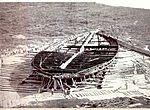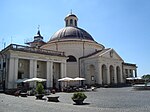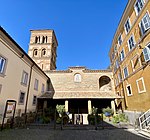Convent of Santa Maria ad Nives of Palazzolo

The church of Santa Maria ad Nives of Palazzolo (also called of Palazzola) is a Catholic place of worship located in the municipality of Rocca di Papa, in the province of Rome, in the suburbicarian diocese of Frascati. Next to the church stands the former convent of the Friars Minor Observant. The convent, which already existed in the 11th century, stands in a picturesque place overlooking Lake Albano: amidst alternate events it reached its period of maximum splendor around the middle of the 18th century, with the architectural interventions promoted by Bishop José Maria Ribeiro da Fonseca de Évora. The convent was a protectorate of the Kingdom of Portugal from 1870 to 1910, until it was handed over to private individuals in 1915. Since 1920 it has hosted a summer stay for seminarians from the Venerable English College.
Excerpt from the Wikipedia article Convent of Santa Maria ad Nives of Palazzolo (License: CC BY-SA 3.0, Authors, Images).Convent of Santa Maria ad Nives of Palazzolo
Via dei Laghi,
Geographical coordinates (GPS) Address Phone number Website Nearby Places Show on map
Geographical coordinates (GPS)
| Latitude | Longitude |
|---|---|
| N 41.743592 ° | E 12.689696 ° |
Address
Villa Palazzola
Via dei Laghi km 10.800
00040
Lazio, Italy
Open on Google Maps










